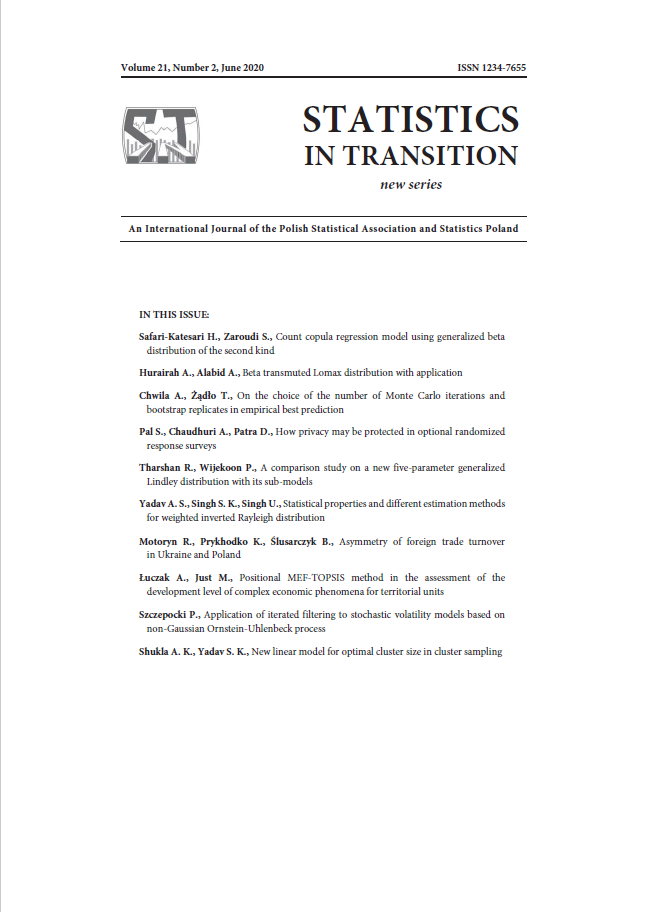ARTICLE
ABSTRACT
The article identifies the determinants of the asymmetry of foreign trade turnover between Ukraine and Poland based on an analysis of competitiveness indicators of the studied countries in the period 2003-2017. The emphasis is on calculation of the comparative advantages of particular commodity headings in Polish exports in the domestic market of Ukraine. Potential directions of the intensification of bilateral trade were evaluated.
KEYWORDS
asymmetry, competitiveness, foreign trade, international cooperation
REFERENCES
BROLL, U., GILROY, M., (1994). Aussenwirtschaftstheorie. Einführung und Neuere Ansätze, München–Wien., pp. 14–36.
DUNNING, J. H., (1992). The Competitive Advantage of Countries and the Activities of Transnational Corporations, Transnational Corporations, No. 2, pp. 11–16.
EUROSTAT, database, https://ec.europa.eu/eurostat/data/database
FALVEY, R. E., KIERZKOWSKI, H., (1987). Product Quality, Intra-Industry Trade and Perfect Competition, Protection and Competition in International Trade, Essays in Honor of W.M. Corden, /red./ H. Kierzkowski, Oxford, pp. 67–72.
GIERSCH, H., (1979). Aspects of Growth. Structural Change and Employment. A Schumpeterian Perspective, Weltwirttschaftliches Archiv, Vol. 115, pp. 1–22
GRIES, T., HENTSCHEL, C., WIGGER, B., (1992). Internationale Wettbewerbsfähigkeit – theoretisches Konzept und empirischer Befund, Universität Göttinge, pp. 27–32.
GRUBEL, H. G., LLOYD, P. J., (1975). Intra-Industry trade. The theory and measurement of international trade in differentiated products, New York, p. 35.
GRZYWACZ, W., (2001).Czynniki wzrostu polskiej konkurencyjności gospodarczej, VII Kongres Ekonomistów Polskich, Warszawa, Sesja II, Zeszyt 17, pp. 1–17.
HORN, E. J., (1985). Internationale Wettbewerbsfähigkeit von Ländern, Tübingen, pp. 188–196.
KOJIMA, K. A., (1974). International Trade and Foreign Investment: Substitutes or Complements, Hitotsubashi Journal of Economics, No. 169, pp. 237–262.
MĄCZYŃSKA, E., (1999). Bezpośrednie inwestycje zagraniczne. Światowe i lokalne czynniki dynamizujące, Ekonomista, No. 1–2, pp. 96.
MICHALET, CH. A., (1984). L’integration, pp. 7–17.
MISALA, J., (1991). Handel zagraniczny Polski a teoria handlu międzynarodowego, Ekonomista, nr 4–6, pp. 487–499.
MISALA, J., (2004). Współpraca gospodarcza Polski z krajami sąsiedzkimi w okresie transformacji, Wydawnictwo Politechniki Radomskiej, Radom, pp.16–28.
PETROSE, E., (1959). The Theory of Growth of the Firm, Basil Blackwell, Oxford, pp. 29–43.
ROCZNIK STATYSTYCZNY HANDLU ZAGRANICZNEGO, GUS, wybrane wydania, www.stat.gov.pl.
SIEBERT, H., RAUSCHER M., (1993). Neuere Entwicklung in der Aussenhandelstheorie, Kiel Working Paper, Institute of World Economics, Kiel, No 476, pp. 17–27.
SOETE, L. L. G., (1990). Technical Change Theory and International Trade Competition, Science Technology and Free Trade, /red./ J. de la Monthe, L. M. Ducharme, London, pp. 123–146.
THE WORLD COMPETITIVENESS REPORT 1994, (1994). World Economic Forum, Luosanne, pp. 18–37.
UNITED NATIONS DATABASE, www.unstats.un.org.
VON STACKELBERG, K., (1991). Internationale Wettbewerbsfähigkeit bei zur nehmenden intra–industriellen Handelsbezichungen mit Schwellenländern: Analyse des Handels der Bundesrepublik Deutschalnd, Niedersachens und Japans mit den Schwellenländern Ost–/Südost–Asien/, Berlin, pp. 61–92.
